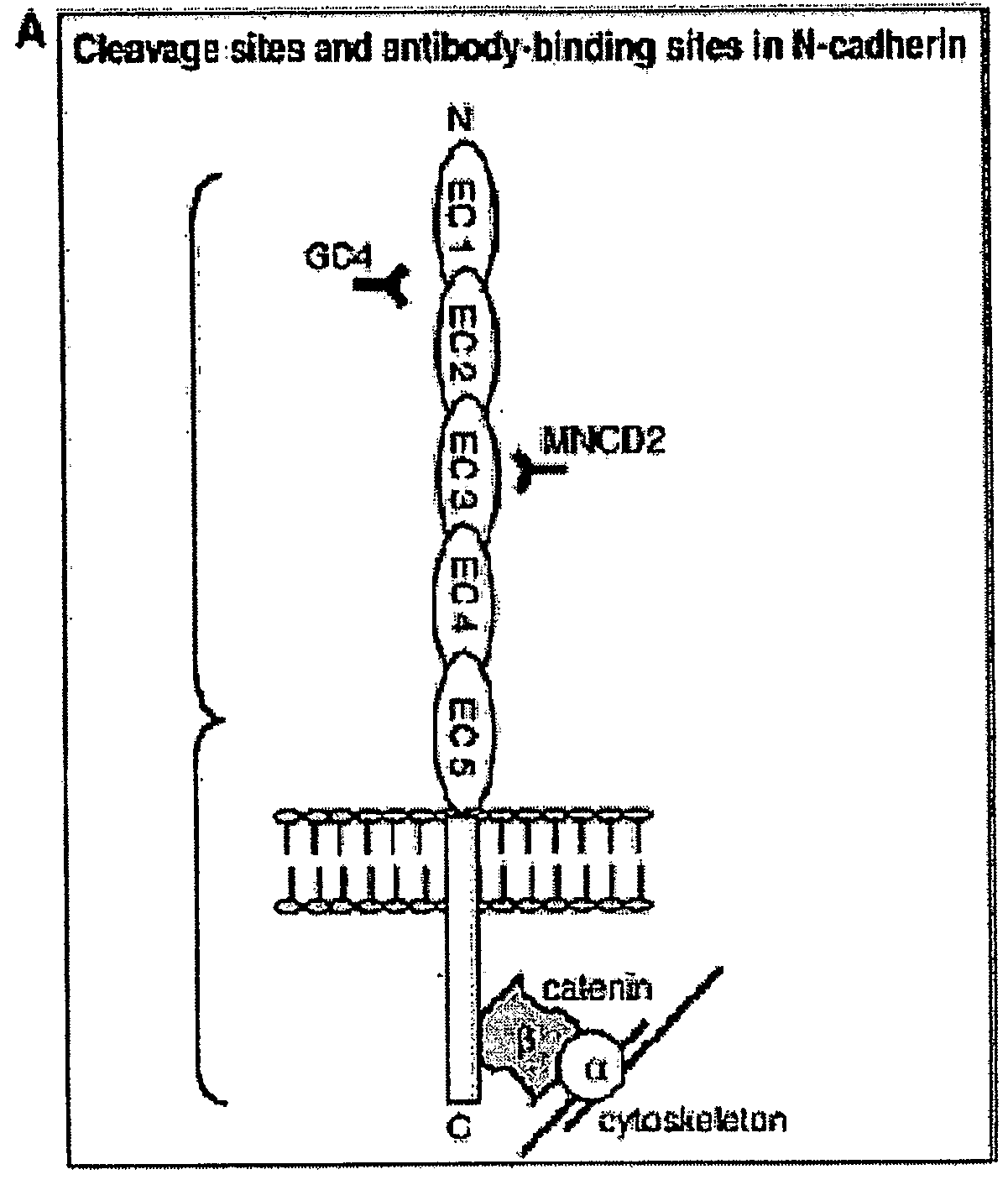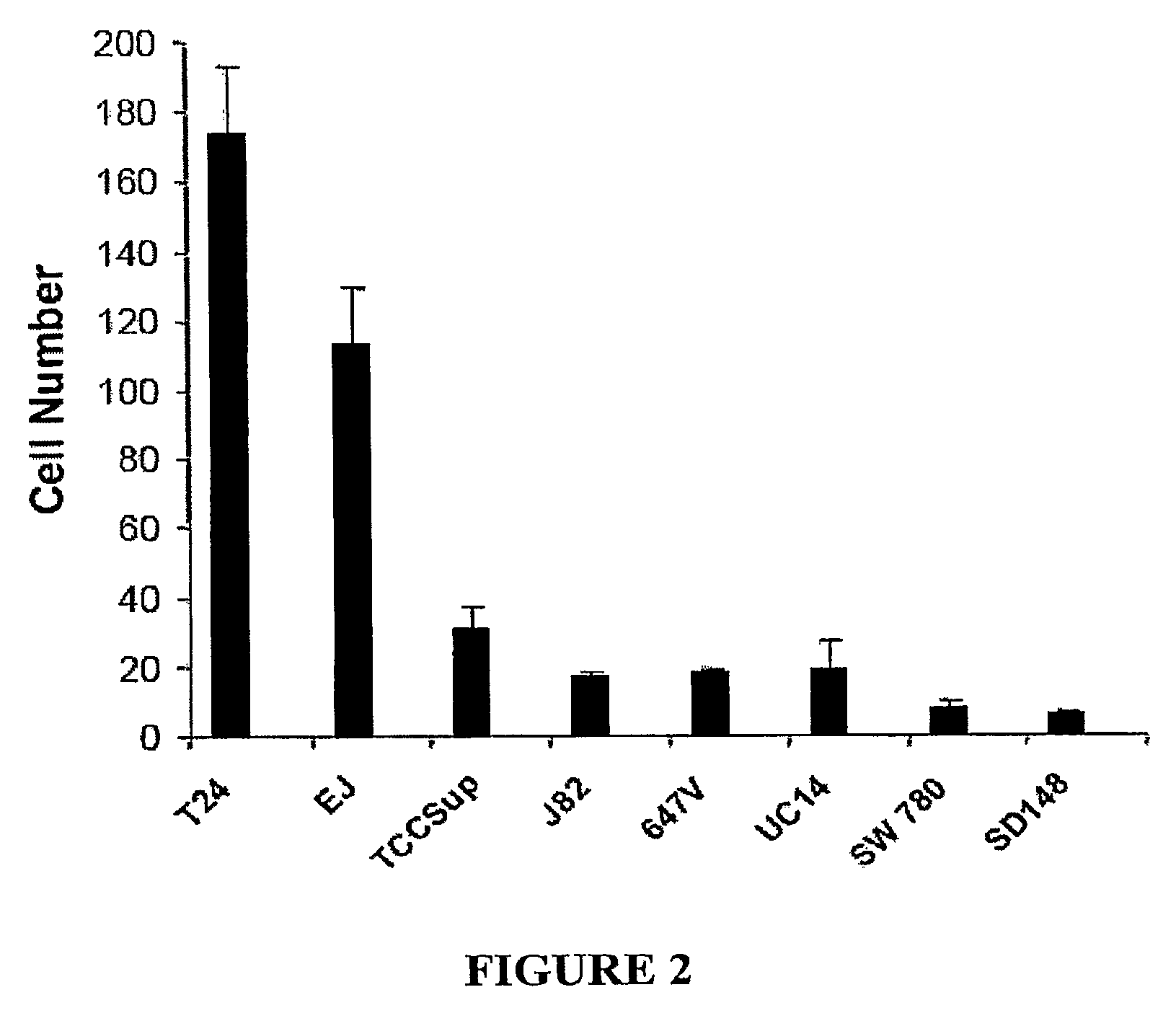N-Cadherin and Ly6 E: Targets for Cancer Diagnosis and Therapy
a cancer diagnosis and therapy technology, applied in the field of n-cadherin and ly6 e, can solve the problems of lack of specificity, limited psa screening, inability to predict, etc., and achieve the effects of promoting the regression of a cancerous tumor, facilitating prognosis, and inhibiting growth
- Summary
- Abstract
- Description
- Claims
- Application Information
AI Technical Summary
Benefits of technology
Problems solved by technology
Method used
Image
Examples
example 1
Materials and Methods
Cell Lines
[0203]The human bladder cancer cell lines (T24, EJ, J82, TCC Sup, 647 V, UC-14, SW780, RT 112, SD 148) were all maintained in RPMI 1640 1× medium (Cellgro) supplemented with 10% fetal bovine serum (Omega Scientific, Inc.) and 1% Penicillin-Streptomycin-Glutamine (PSG) (Invitrogen) at 37° C. in a humidified 5% CO2 atmosphere.
Reagents and Antibodies
[0204]Mouse mAb against E- and N-cadherin were acquired from Zymed Laboratories Inc. (San Francisco). Another mouse anti-N-cadherin Ab (clone GC-4, Sigma, Saint-Louis) was used to neutralize N-cadherin function in Boyden chamber assays. Rabbit mAb against pan-Akt and pAkt (Ser 473) were purchased from Cell Signalling Technology. Mouse mAb anti-PTEN antibody was acquired from Santa Cruz Biotechnology. Polyclonal anti-Epidermal Growth Factor Receptor Phosphospecific antibody (PY1068) was purchased from Biosource. LY294002 hydrochloride (PI3K inhibitor) was purchased from Sigma. It was dissolved as a concentrated...
example 2
N-Cadherin Expression in Bladder Cancer Cell Lines is Associated with Akt Activation, Loss of E-Cadherin, and Invasive Behavior
[0216]To study the possible role of EMT in bladder cancer, we first screened a panel of bladder cancer cell lines for N-Cadherin and E-Cadherin expression. As shown in FIG. 1A, N-Cadherin is expressed in four of six cell lines (TCC, EJ, J82 and T24) and absent in two of six (UC14 and SW780). There is a strong inverse relationship between N-Cadherin and E-Cadherin expression, consistent with previous reports of a cadherin “switch” in cells that have undergone an EMT. UC14 and SW 780 express the highest levels of E-Cadherin and is N-Cadherin negative, while one N-cadherin positive line (TCC) retains low level expression of E-Cadherin. Based on a recent study suggesting that N-cadherin can activate Akt, we also assayed the cells for phospho- and total Akt levels. There is a marked association between N-Cadherin expression and Akt activation, with all N-Cadherin...
example 3
P-AKT Pathway Activation and Inhibition Depend on N-Cadherin or P-EGFR Expression in Invasive Human Bladder Cell Lines
[0219]The PI3 kinase-Akt pathway is central to tumour progression and metastasis in human cancer and is believed to play a critical role in bladder cancer invasion. However, little is known about the upstream signals that activate Akt in bladder cancer. The N-cadherin and epidermal growth factor receptor (EGFR) signalling pathways were investigated in order to evaluate their involvement in activating Akt in several invasive human bladder cell lines. The molecular and functional effects of N-cadherin and EGFR inhibition in these cell lines was also investigated.
[0220]A panel of invasive and noninvasive bladder cancer cell lines were screened for activated EGFR, N-cadherin, E-cadherin, activated Akt and PTEN expression by Western Blot. Cells were evaluated with and without the EGFR antagonist Iressa, the N-cadherin blocking antibody GC-4, and the PI3K inhibitor LY29400...
PUM
 Login to View More
Login to View More Abstract
Description
Claims
Application Information
 Login to View More
Login to View More - R&D
- Intellectual Property
- Life Sciences
- Materials
- Tech Scout
- Unparalleled Data Quality
- Higher Quality Content
- 60% Fewer Hallucinations
Browse by: Latest US Patents, China's latest patents, Technical Efficacy Thesaurus, Application Domain, Technology Topic, Popular Technical Reports.
© 2025 PatSnap. All rights reserved.Legal|Privacy policy|Modern Slavery Act Transparency Statement|Sitemap|About US| Contact US: help@patsnap.com



